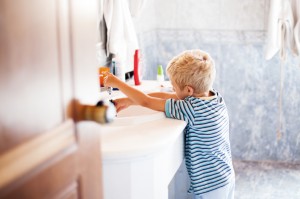
Many of us may be familiar with the impact a
1st, 2nd, or 3rd degree burn may have on the human body, but most of us aren’t as familiar with the impact a scald can have. Since scald recognition and prevention may not be discussed as often as burns, let's talk about scalds and how you can prevent scald injuries in your home.
What’s the difference between a burn and a scald?
Understanding the definition and differences of these two injuries will help you decide if the pain you or a loved one is experiencing is a burn or a scald.
Burns: Although burns are complex injuries with no solid definition, in simplest terms a burn can be defined as damage to skin cells and tissue caused by fire, heat, electricity, chemicals, radiation, light, or friction. If the burn is severe, it can even damage muscle and fat. And if it's deep enough, it can reach bone.
Scalds: Unlike burns, scalds may only damage several layers of skin. They typically don’t reach connective or nerve tissue, muscle, fat, or bone. However, while many scalds can be considered as superficial or first degree burns, if severe enough, scalds can be just as fatal as a third degree burn and may even lead to death. A scald is caused when a portion of skin is exposed to a
hot liquid or steam. For instance, scalding is often caused by hot bath water, hot food, cooking fluids like grease, or a hot drink.
What's the impact of a scald injury?
Many people may believe that scalds are not serious burn injuries. But it's important to understand that, like second and third degree burns, scalds may require skin grafting and can have deadly effects if not treated in time.
According to
U.S. News and World Reports, “In the United States, burns from hot tap water result in about 1,500 hospital admissions and 100 deaths per year.” The difference between a scald being a minor burn or being deadly are determined by several factors including:
- Prolonged exposure to the hot substance
- The temperature of the substance
- The nature of the substance (is it sticky? does it retain heat?)
- The extent of body area scalded
- The location of the scald
Also, scalds can happen fast.
Shriner’s Hospital states, “People of all ages can be burned in 30 seconds by flowing liquid that is 130 degrees F; at 140 degrees F, it takes only 5 seconds; at 160 degrees F, it only takes 1 second.”
Who typically experiences scalding?
Even though people of all ages can be scalded, the three groups that are most likely to experience a scald are young children, the elderly, and those with disabilities and special needs. These groups may not be able to say or understand that their bath water or drink is too hot. And because of mobility restrictions, they may not be able remove themselves from an unsafe situation.
Additionally, young children and the elderly typically have thinner skin than the average adult or teen. The thinner your skin, the quicker it’ll burn making these groups more susceptible to scalding.
But just because the three groups listed above are more likely to experience a scald, let's not forget that a scald injury can happen to anyone. It's important to learn preventative measures now to make sure you and your family are safe.
How can I prevent scald injuries in my home?
Scalds typically occur at home in the bathroom or kitchen. Since we know the two most common places where they occur, you can enact preventative measures in your home now.
Bathroom Safety
- Supervise young children as they use tap water to wash hands, face, etc. (According to Safe Kids USA, “hot tap water burns tend to be the most severe and cover a larger portion of the body than other scald burns.”)
- Lower the temperature setting on your water heater to 120°F or less.
- To check water temperature when filling the tub for a child, move your hand through the water. If it feels too hot for you, it’s definitely too hot for a child, elderly, or those with special needs.
- Place your child on the opposite end of the tub from the faucet. Position them so their back is toward the faucet.
- Install a grab bar in your shower.
- A safe bathing temperature for a healthy adult is 100°F ( to test the water temperature, run water for 2 minutes and use a cooking thermometer to measure heat.)
Kitchen Safety
- When cooking, face pot handles inward so that no one can walk past and accidently hit the pot or so a child can’t pull it off the stove.
- Follow instructions and cautions for heating items in a microwave—even the steam from a bag of popcorn can scald you.
- Supervise children in kitchen and dining areas.
- Mark a “kid-free zone” in the kitchen close to the stove (with tape) and explain to your child why they cannot cross the line.
- Never hold a child in your arms while preparing hot foods or liquids.
- Keep hot foods and liquids high out of a child’s reach.
- Keep BurnFree in your kitchen or first aid kit
To learn more about scald prevention safety and tips, check out these links
- http://www.ameriburn.org/Preven/2000Prevention/Scald2000PrevetionKit.pdf
And while you’re at it, beef up on first aid for 1
st, 2
nd, 3
rd degree, and chemical and electrical burns in our article, “
First Aid for Burns.” You could even use these tips to help you treat a minor scald.
Sources
- http://health.usnews.com/health-news/news/articles/2013/03/31/hot-tap-water-may-pose-scalding-hazard
- http://www.safekids.org/sites/default/files/documents/2013%20Burns%20FINAL_0.pdf


1 comment
roof glass
See below for a list of glaziers near you.